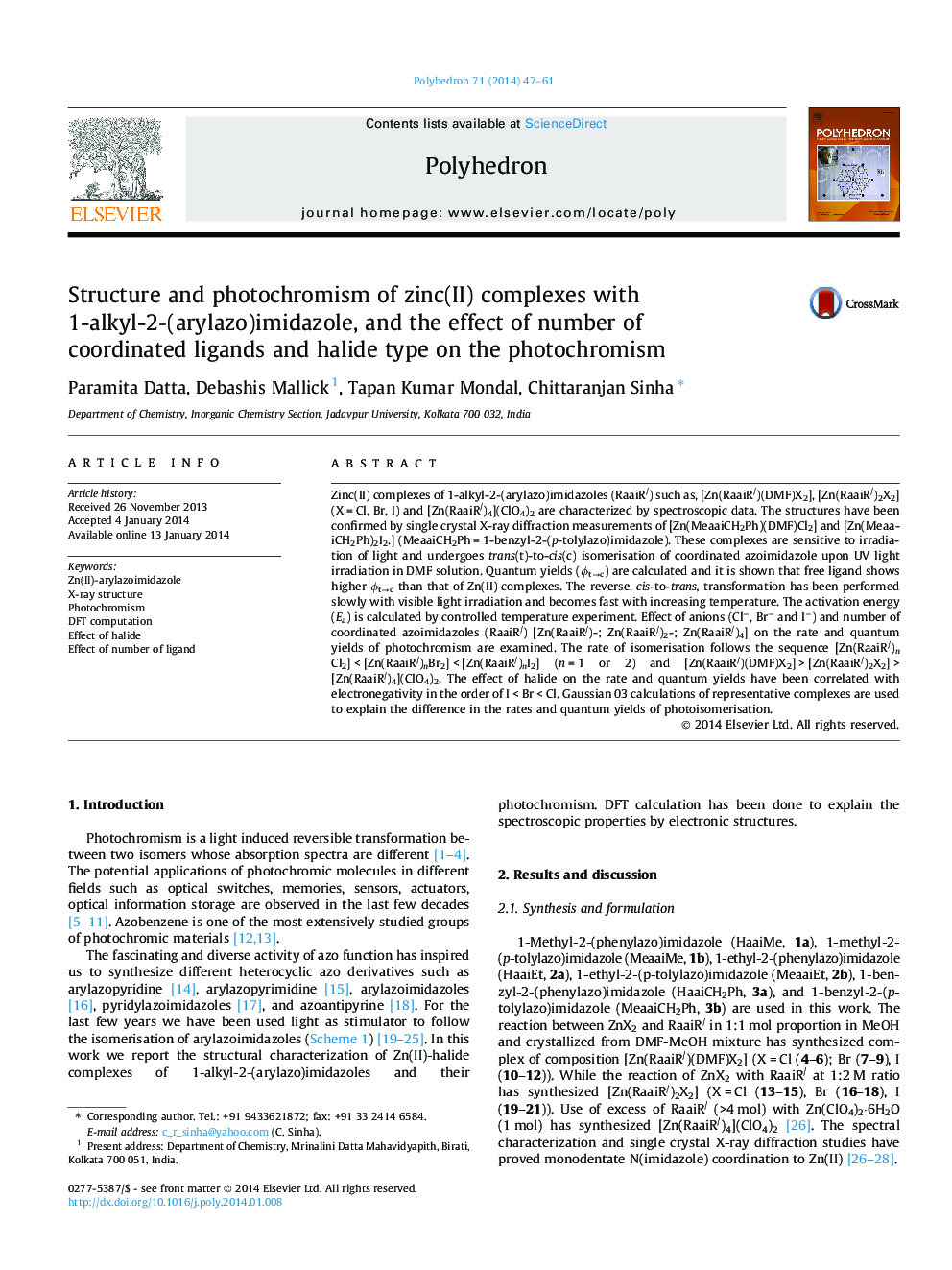| Article ID | Journal | Published Year | Pages | File Type |
|---|---|---|---|---|
| 1336699 | Polyhedron | 2014 | 15 Pages |
Zinc(II) complexes of 1-alkyl-2-(arylazo)imidazoles (RaaiR/) such as, [Zn(RaaiR/)(DMF)X2], [Zn(RaaiR/)2X2] (X = Cl, Br, I) and [Zn(RaaiR/)4](ClO4)2 are characterized by spectroscopic data. The structures have been confirmed by single crystal X-ray diffraction measurements of [Zn(MeaaiCH2Ph)(DMF)Cl2] and [Zn(MeaaiCH2Ph)2I2.] (MeaaiCH2Ph = 1-benzyl-2-(p-tolylazo)imidazole). These complexes are sensitive to irradiation of light and undergoes trans(t)-to-cis(c) isomerisation of coordinated azoimidazole upon UV light irradiation in DMF solution. Quantum yields (ϕt→c) are calculated and it is shown that free ligand shows higher ϕt→c than that of Zn(II) complexes. The reverse, cis-to-trans, transformation has been performed slowly with visible light irradiation and becomes fast with increasing temperature. The activation energy (Ea) is calculated by controlled temperature experiment. Effect of anions (Cl−, Br− and I−) and number of coordinated azoimidazoles (RaaiR/) [Zn(RaaiR/)-; Zn(RaaiR/)2-; Zn(RaaiR/)4] on the rate and quantum yields of photochromism are examined. The rate of isomerisation follows the sequence [Zn(RaaiR/)nCl2] < [Zn(RaaiR/)nBr2] < [Zn(RaaiR/)nI2] (n = 1 or 2) and [Zn(RaaiR/)(DMF)X2] > [Zn(RaaiR/)2X2] > [Zn(RaaiR/)4](ClO4)2. The effect of halide on the rate and quantum yields have been correlated with electronegativity in the order of I < Br < Cl. Gaussian 03 calculations of representative complexes are used to explain the difference in the rates and quantum yields of photoisomerisation.
Graphical abstract[Zn(RaaiR/)(DMF)X2] and [Zn(RaaiR/)2X2] (RaaiR/ = 1-alkyl-2-(arylazo)imidazole and X = Cl, Br, I) are structurally characterized and the UV light irradiation in DMF solution of the complexes show trans-to-cis isomerisation of coordinated azoimidazole. Quantum yields (ϕt→c) of free ligand are higher than their complexes. The cis-to-trans transformation is a thermal process and the activation energy (Ea) of the complexes is lower than free ligands. The rate of isomerisation follows [Zn(RaaiR/)2X2] < [Zn(RaaiR/)(DMF)X2] and [Zn(RaaiR/)nCl2] < [Zn(RaaiR/)nBr2] < [Zn(RaaiR/)nI2] (n = 1 or 2). It may be related to rotor volume and mass; size and electronegativity of halide which increases the effective molar association in the order of I < Br < Cl. DFT and TD-DFT computations of representative complexes are used to explain the difference in the rates and quantum yields of photoisomerisation.Figure optionsDownload full-size imageDownload as PowerPoint slide
